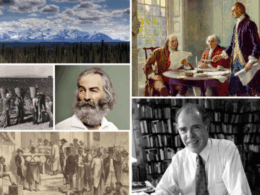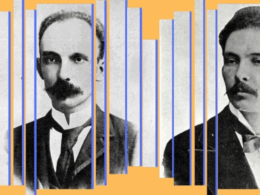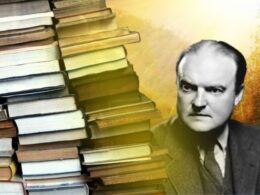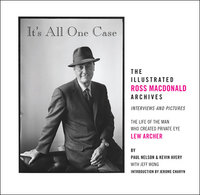
A major new entry into the critical literature on crime novelist Ross Macdonald arrives this fall with the release of It’s All One Case: The Illustrated Ross Macdonald Archives from Fantagraphic Books. Editor Kevin Avery has transcribed and shaped dozens of hours of interviews that the journalist–critic Paul Nelson recorded with Macdonald in 1976 into a notably unguarded portrait of the author that touches on everything from his complicated family history to his literary influences and his aspirations for the genre that he helped elevate. Alongside Library of America’s ongoing edition of Macdonald’s Lew Archer novels, the book testifies to a major resurgence of interest in the author and his work.
The content of It’s All One Case is matched by the splendor of its presentation. Published in a deluxe coffee-table format, the book is lavishly illustrated with color reproductions of Macdonald dust jackets and paperback reprints from around the world, limited editions, manuscript pages, magazine spreads, memorabilia from movie and TV tie-ins, and photographs of Macdonald and his wife, fellow mystery–suspense writer Margaret Millar.
If the design and content seem unusually well integrated, that’s because the designer of It’s All One Case, Jeff Wong, is also a Ross Macdonald devotee who holds one of the largest private archives of Macdonald materials known to exist. Via email, Wong talked to Library of America about his near-lifelong enthusiasm for the author and what it was like to work on a veritable dream project.
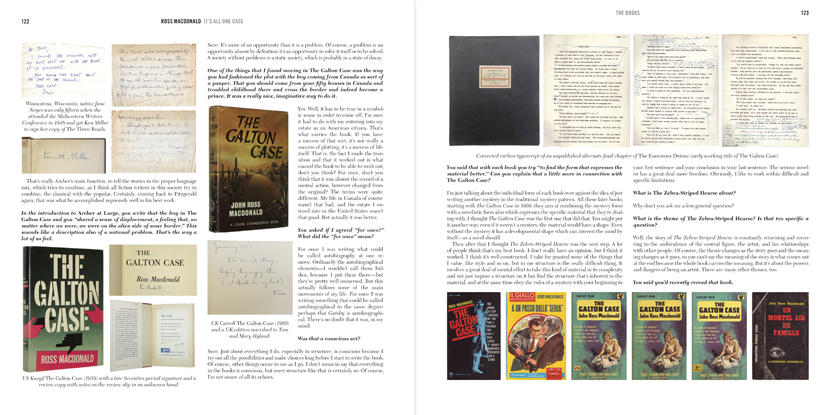
LOA: You’re the owner of one of the largest archives of Ross Macdonald collectibles anywhere in the world. Can you tell us a little bit about what initially piqued your interest in Macdonald’s writing, and how you got started collecting?
Wong: Owner? Yes, but in reality . . . caretaker, really, because you can’t take it with you. A more accurate description might be that it’s the most in-depth Kenneth Millar/Ross Macdonald collection in private hands—I’m certain there are collectors with more typescripts out there. What sets my collection apart is that it’s broader in scope and more thorough than any others.
What started it all: I took a detective fiction course in college at the School of Visual Arts. My teacher, Martin Smith (author of Flora’s Dream and Goodbye, Philip Roth) had us read an array of crime and mystery novels, and one of them was The Galton Case, which he thought was “a gem.” I immediately fell in love with the work and sought more. Apart from the obvious qualities like the beauty of Millar’s use of simile, metaphor, nearly airtight plots (in which he generally played fair, allowing the reader to solve the mystery if you paid careful attention), I was really impressed with what he referred to as echoes—deliberate repetitions of themes throughout the book, that created a depth and layering not often seen in mysteries. In The Chill, he uses bird imagery this way and also foreshadows human events using scenes with birds. A black Thunderbird convertible is mentioned at the beginning of Chapter Five and Chapter Six; later in the book, blackbirds are mentioned six times in Chapter Twenty-six.
Chapter Six:
A wild pigeon lay on the patio with its iridescent neck broken. Its faint spread-eagled image outlined in dust showed where it had flown against the glass.She pulled away from me, so violently that she thudded like a bird against the glass wall.
Chapter Nine:
An owl flew low over our heads, silent as a traveling piece of fog. It lit somewhere in the gray darkness, called to its mate, and was answered. The two invisible birds seemed to be mocking us with their sad distant foghorn voices.The fog outside was getting denser. It moved against the glass wall of the house, and gave me the queer sensation that the world had dropped away, and Bradshaw and I were floating together in space, unlikely gemini encapsulated with the dead woman.
In The Zebra-Striped Hearse, black, white, and gray imagery is constantly used.
This kind of richness woven into his books made me hungry for more. I began modestly collecting paperbacks to read any of his titles I could find. Book Row was at the tail end of its existence and I poked around a lot of shops in the East Village hunting for his novels. As an artist, I was fascinated by the different cover art of the same paperback titles that spanned decades: illustrated covers from the ’50s, photo covers from the ’60s, typographic covers in the ’70s—this especially appealed to my interest in package design. My father was a package designer of some note—he was employed by Frank Gianninoto in the 1950s and worked on the Marlboro cigarettes package when it was being changed from a women’s brand to the red and white one we know today (my father also designed the original Milky Way candy bar wrapper, and Three Musketeers, among others).
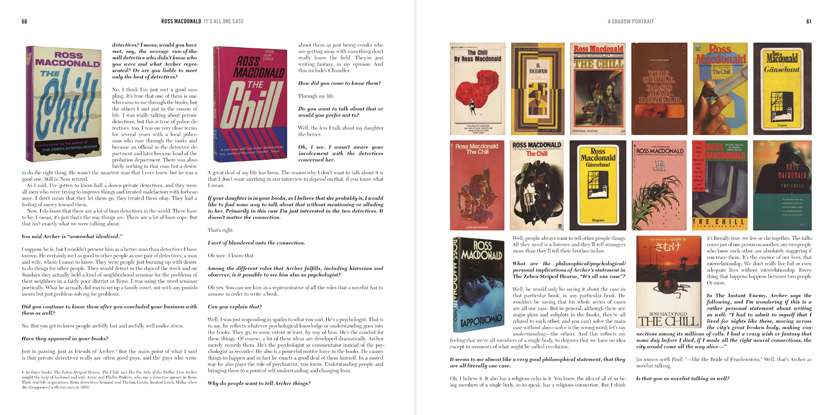
Occasionally I’d treat myself to a hardcover book club edition. There was a comforting feeling of having the weight of a hardcover book in my hands while reading curled up in a chair. At one point, I asked Otto Penzler if there was a later-printing hardcover, or book club edition of The Galton Case, to which he replied, “There may be, but collecting first editions is the only way to go.” I made a mental note of this, but didn’t think about first editions or know much about them then.
However, that Christmas, my girlfriend at the time came across the signed, limited-edition Lew Archer, Private Investigator that Otto had published in 1977, and bought it for me as a present. That got me hooked: the idea that Kenneth Millar [Ross Macdonald’s real name] had somehow handled and signed the book thrilled me (at the time, I didn’t know about signed pages getting bound or tipped in and that Millar didn’t really handle the book itself). We picked up The Armchair Detective and began writing to various dealers inquiring about first editions of Millar/Macdonald. Over time, the casual hobby developed into in-depth collecting. Rare book dealer Ralph Sipper, who was the literary executor of Ken Millar’s estate, got me started on acquiring holograph manuscripts, for which I’m forever grateful. Seeing Millar’s thinking process captured on paper was a privilege and absolutely revelatory.
LOA: How many items would you say the archive contains overall? (And just where do you store so much material?)
Wong: That’s not easy to answer because I haven’t counted it all. The collection comprises first and later editions from all countries in all languages I could locate, handwritten letters and drafts of letters (essentially Millar’s own file copies) that span forty years’ time, various manuscripts, typescripts, photographs (most of which couldn’t be reproduced in It’s All One Case because of time-consuming rights clearances), movie tie-ins (films, screenplays, paper ephemera), author blurbs, author recordings (which include Paul Nelson’s 1976 interviews and serve as the source for It’s All One Case’s text).
I included about 1,300 images of material from my collection and it amounts to a portion of what I’ve got . . . at last count, the collection is in excess of seventy-five or eighty linear feet of shelf space. Generally speaking, I only included images that had some kind of contextual link to the interview text. I wasn’t able to share everything. I’d be remiss if I didn’t mention that both the hardcover and paperback versions of Hardboiled America: The Lurid Years of Paperbacks by [Library of America Editor-in-Chief] Geoffrey O’Brien are part of the collection.
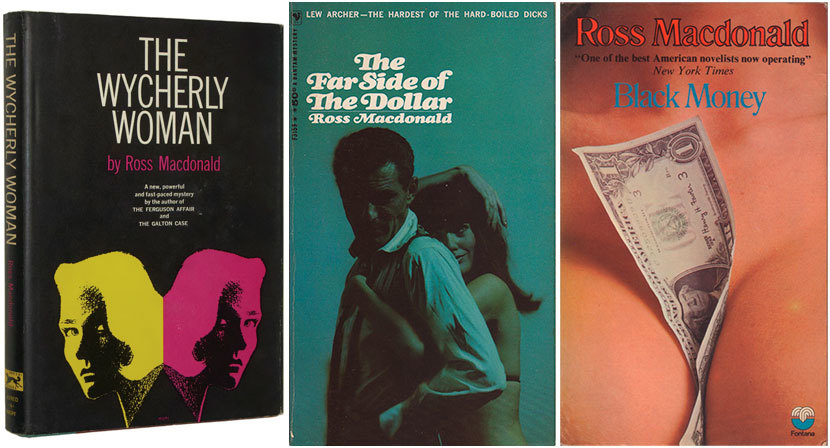
LOA: From the later 1950s and through the ’60s, the dust jackets of Macdonald’s Alfred A. Knopf hardcovers get more sophisticated while the paperback reprints grow increasingly lurid. In fact, many of the latter promise far more sex and violence than is actually contained within their covers. Do we know if Macdonald himself ever commented on some of these racier editions?
Wong: The only commentary on his paperback packaging that comes to mind is when he wrote to Dorothy Olding (his agent at Harold Ober and dedicatee of The Wycherly Woman, whom I was fortunate enough to meet at the 1989 Edgar® Awards) about Bantam issuing box sets of his books in the early ’70s—Tom Nolan mentions this in his wonderful biography.
At this time, I don’t have any letters where anything is said about these lurid covers. I know Ken Millar/Ross Macdonald usually wrote the dust jacket copy for his own and Maggie’s hardcovers. I doubt he had anything to do with “LEW ARCHER—THE HARDEST OF THE HARD–BOILED DICKS” used on the mid-1960s Bantam paperback editions. This kind of marketing was used to ride the wave of Mickey Spillane’s success—he was selling millions of books featuring his tough guy private eye, Mike Hammer, but it’s almost certainly the brainchild of someone at Bantam. The busty photographic covers of the UK Fontana paperbacks had so little to do with what was between the covers, but they probably resulted in sales since the same packaging ended up being used for several years.
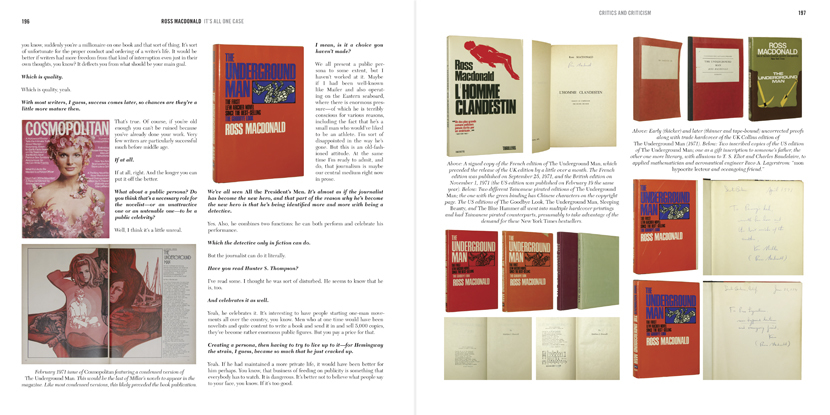
LOA: Your biographical note at the end of It’s All One Case mentions your involvement in a project to restore all of Margaret Millar to print. We republished her 1955 novel Beast in View last year, as part of our Women Crime Writers of the 1940s & 50s collection, so naturally we’re interested. Care to elaborate?
Wong: Paul Oliver, of Syndicate Books, acquired the rights to the complete works of Margaret Millar. I’m illustrating and designing all of the e-books and print volumes. These releases are significant because it will be the first time in history that all of Maggie’s books will be in print by the same publishing house. It’s a very ambitious project and I’m honored to be involved. To be associated with the work of both Maggie and Ken is beyond words, especially for a collector of the work of both authors.
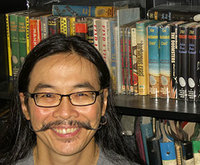
That I had a hand in bringing the interviews my late friend Paul Nelson did with Ken Millar into the world and was able to present them in a specially printed and aesthetically pleasing format makes me so proud. I’m grateful to Kevin Avery for taking on the Herculean task of editing and shaping the mountain of interviews into a cohesive book. When your career collides with your passion, there’s nothing else like it. I first experienced this when I worked with Tom Nolan on The Archer Files, and illustrated and designed the cover to what was (at the time) the definitive collection of Ross Macdonald short stories. It was surreal to become part of my own collection.
LOA: Finally, because we have to ask: where or how do the Library of America editions of Ross Macdonald fit into your collection? (A third and final volume is scheduled for mid–2017.)
Wong: I’d say the Library of America editions are essential, especially if you had to limit your Ross Macdonald books to just a few—Tom’s selections make great sense. You’d find them, as newer releases, at the end of my shelf in chronological order.
